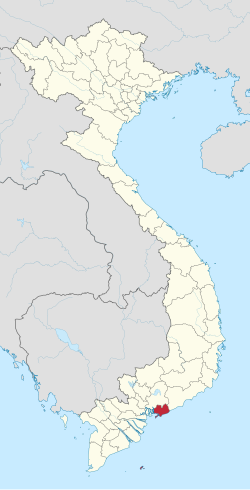Bà Rịa-Vũng Tàu Province
|
Bà Rịa-Vũng Tàu Province Tỉnh Bà Rịa-Vũng Tàu |
|
|---|---|
| Province | |
 |
|
| Coordinates: 10°35′N 107°15′E / 10.583°N 107.250°ECoordinates: 10°35′N 107°15′E / 10.583°N 107.250°E | |
| Country |
|
| Region | Southeast |
| Capital | Bà Rịa |
| Former seat | Vũng Tàu (until 2 May 2012) |
| Government | |
| • People's Council Chair | Nguyễn Tuấn Minh |
| • People's Committee Chair | Trần Minh Sanh |
| Area | |
| • Total | 1,989.5 km2 (768.2 sq mi) |
| Population (2015) | |
| • Total | 1,072,600 |
| • Density | 540/km2 (1,400/sq mi) |
| Demographics | |
| • Ethnic groups |
97.53% Vietnamese |
| Time zone | ICT (UTC+7) |
| Area codes | 64 (until 16 July 2017) 254 (from 17 June 2017) |
| ISO 3166 code | VN-43 |
| Website | www |
97.53% Vietnamese
Bà Rịa-Vũng Tàu (Hanoi accent: [ɓa˨˩ ɹɨə˨˧ vuŋ˧ˀ˥ taʊ̯˨˩], Saigon accent: [ɓa˨˩ ɹɨə˨˧ vuŋ˧˩˧ taːw˨˩]) is a province of Vietnam. It is located on the coast of the country's Southeast region. It also includes the Côn Đảo islands, located some distance off Vietnam's southeastern coast. From 1954 to 1975, this province belonged to South Vietnam with the name Phước Tuy.
With the exception of the Côn Đảo islands, all of Bà Rịa-Vũng Tàu Province was once a part of Đồng Nai Province to the north. In 1979, Vũng Tàu was broken away from Đồng Nai and merged with the Côn Đảo islands (formerly part of Hậu Giang Province), forming the new Vũng Tàu-Côn Đảo "special zone". Later, in 1992, Bà Rịa broke away from Đồng Nai Province, merging with Vũng Tàu-Côn Đảo to form the modern province of Bà Rịa-Vũng Tàu.
Bà Rịa-Vũng Tàu is subdivided into 8 district-level sub-divisions:
They are further subdivided into 8 commune-level towns (or townlets), 49 communes, and 25 wards.
According to 2015 statistics from the General Statistics Office of Vietnam, the province has a population of 1,072,600.Urbanization in the province is above the country's average (50.52%).
Bà Rịa-Vũng Tàu provincial economic activities include: petroleum (the most important), electricity at the Phú Mỹ Power Plants and Bà Rịa Power Plant (accounting for approx. 40% of the country's total power capacity), petrochemicals: Phu My Urea Plant (800,000 metric tonnes per year, polyethylene (100,000 metric tonnes/year), steel production, and cement production. Tourism, commerce and fishing are also important economic activities of the province. Bà Rịa–Vũng Tàu contributes greatly to the country's budget. In 2005, it accounted for around 24 percent of Vietnam's budget (42,000 billion dong) of a total of 180,000 billion dong (exchange rate is 16,000 dong/dollar), ranking second, after Ho Chi Minh City before Hanoi (28,000 billion dong in 2005). The provincial GDP per capita ranks second to none in the country, over $4,000, if excluding petroleum GDP, it is over $2000 (Hồ Chí Minh City ranks second with this index $1,850). In term of living standards, Bà Rịa-Vũng Tàu ranks third, behind Hồ Chí Minh City and Hanoi.
...
Wikipedia
